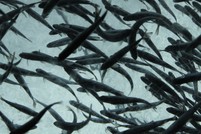
A new field study reports a decrease in the number of abnormal intersex fish living downstream of Kitchener, Ontario after effluent processing changes were made at the town’s wastewater treatment plant.
The article, published in the February 7th issue of Environmental Science and Technology, show how changes made at the Kitchener wastewater treatment plant lowered the number of rainbow darter with reproductive abnormalities. The plant upgrade included the addition of a nitrifying procedure, which reduced the effluent’s estrogen levels. Researchers from the University of Waterloo, the Ontario Ministry of Climate Change, and Environment Canada collected fish from the Grand River both before and after processing changes. Fish were also collected from a clean upstream site and from a site downstream of another wastewater treatment plant. This plant in Waterloo did not undergo any processing changes. Intersex fish have the reproductive tissues of both males and females. In male fish, intersex is measured as the number of egg cells in the testes. Intersex fish were first discovered in 2003 by USGS researchers in West Virginia. More studies have since found large numbers of intersex fish across North America. Exposure to hormones such as natural and synthetic estrogen is thought to be the culprit for these intersex characteristics. This study looked for the presence of intersex in a small freshwater fish species, the rainbow darter, from 2007 through 2015. Effluent processing changes were made in mid-2012. Darters collected from the clean site had low numbers of intersex (less than 20%) and the levels did not change during the study. Downstream of the Kitchener plant, as many as 100% of fish sampled were intersex before 2012. The level of intersex in these fish dropped by more than 75% by the end of 2015. The number of intersex fish was consistent at the site where there were no effluent processing changes. The estrogen levels were measured before and after plant upgrades. Estrogen levels in the Kitchener wastewater treatment plant decreased after 2012. There were also lower levels of pharmaceuticals, including ibuprofen, naproxen, and carbamazepine. Estrogen exposure isn’t limited to intersex in fish. A lake-wide study found that estrogen exposure could wipe out entire fish populations. Male fish exposed to estrogens also have lower testosterone levels and smaller testes. Treatment changes made at the Kitchener plant included nitrification of the activated sludge. This involves adding bacteria that convert ammonia to nitrogen. Previous studies showed that nitrification of sludge could reduce the amount of hormones in effluents, but this is the first study to show positive impacts on fish populations. Since rainbow darter can live up to five years, the population’s recovery over the three year period shows that intersex is not permanent. One confounding result from this study is the increase in effluent nitrogen levels. While ammonia, pharmaceuticals, and estrogen levels decreased, nitrates increased to 20 mg/L. The EPA recommends that nitrate levels in drinking water be no higher than 10 mg/L. Higher nitrogen levels promote algae overgrowth that can lead to decreases in oxygen, a process known as eutrophication. Future work at this site will need to ensure that nitrogen levels are not causing other types of environmental damage. Comments are closed.
|
Archives
August 2018
Categories
All
|
Addtext

 RSS Feed
RSS Feed